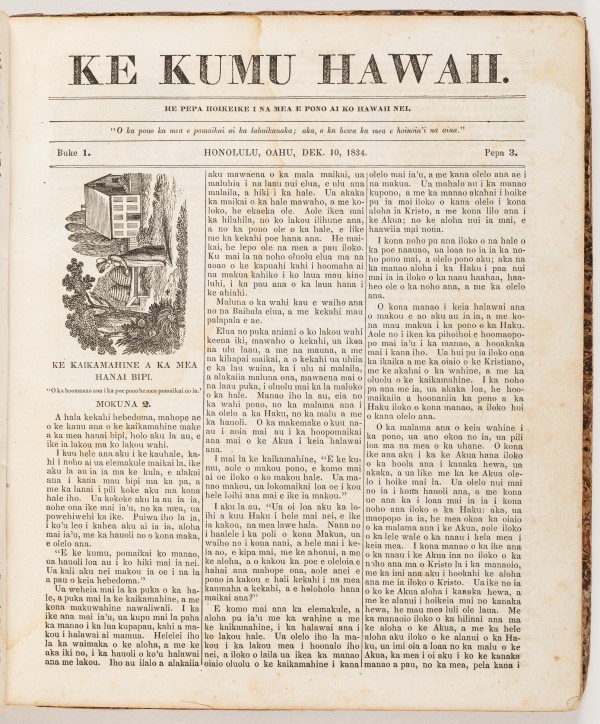
About this Resource | People in the Collection
A Native Hawaiian aliʻi (upper class leader), a 22-year-old printer's apprentice/missionary from New York, and a sailor from Massachusetts all gathered around a second-hand Ramage printing press one morning in early January 1822.
The missionary, sailor, and printing press had all arrived on the same ship in 1820, sent by the American Board of Commissioners for Foreign Missions in Boston. The printing press was set up in one of the hale pili (grass thatched house), built by the Hawaiian Kingdom, for the newly established "Sandwich Islands Mission" in Honolulu. The three men took turns pulling the bar of the press to strike the first few impressions of the first printing on the Hawaiian Islands. No existing copies of those initial printings are known. The Alphabet (1822) has the distinction of being the earliest surviving printing done on the Islands. Within the first few decades of printing in the Hawaiian language, missionaries estimated over 30 million pages were printed on the Islands.
The Hawaiian Language
Forcing the Hawaiian language into a printed form was a result of strained collaborations between Native Hawaiians (including some Native Hawaiian missionaries) and missionaries from the United States. The Hawaiian language had been an oral tradition extending back millennia and a handwritten tradition going back decades. Native Hawaiians had also been developing the written form of their language after initial contact with Europeans in the late 1700s – Native Hawaiians had been hand-writing letters to each other in Hawaiian (see Ali'i Letters at the Hawaiian Mission Houses Digital Collections) and creating manuscript publications.
Lahainaluna Seminary

Catalog record
Lahainaluna Seminary, located just above Lahaina on the island of Maui, is central to the history of Hawaiian language printing. Also known as the High School or Kulanui o Hawaii nei, ma Lahainaluna i Maui, the Seminary was established in September 1831 by ABCFM missionaries. It began as a training school for Native Hawaiian adult teachers, many of whom were married and arrived with their families.
The original Ramage press, brought to the Islands in 1820, was moved to the Lahainaluna campus in 1833 after a second printing press arrived in Honolulu. Its new home, Hale Pa'i, or the house of printing, served as a hub for the creation and dissemination of information. Students learned how to set type, operate the press, create copper engravings, and bind books. The press was used to print textbooks, teaching aids, English and Hawaiian language Bibles, books, newspapers, and even the first paper currency of Hawaii.
After the first class of adult students graduated in 1835, Lahainaluna became a boarding school for boys as young as 10 in 1836. Later control of the school transferred to the Hawaiian government in 1849.
Native Hawaiian students or local Hawaiians provided almost all the labor to operate the Seminary printing and engraving presses in the 1830s and 1840s. They also translated and co-authored works. Lorrin Andrews, the US missionary who promoted and supervised the work of printing and engraving at Lahainaluna in these early decades, described his role in the actual work as merely that of pulling the press for physical exercise. Testimony of one of the best Native Hawaiian engravers, Kepohani, confirms this. He wrote: "it was I who did the tasks Andrews held in his hands from the years 1836 to 1844." (In an 1847 letter in Hawaiʻi State Archives cited in Forbes, D.W. Engraved at Lahainaluna, 2021, p. 23.)
Related catalog records for Lahainaluna Seminary printing
Engravings
Students at Lahainaluna Seminary, local Hawaiians, and missionaries taught themselves how to do copperplate engraving and printing, and between 1834 and 1844 they created dozens of engravings. Some of the most striking and technically skilled examples of Hawaiian printing, the engravings include maps, landscape views, portraits, and depictions of native floral as both book illustrations and as separately published prints.
For more information, see David W. Forbes. Engraved at Lahainaluna: A History of Printmaking by Hawaiians at the Lahainaluna Seminary, 1834 to 1844, with a descriptive catalogue of all known views, maps, and portraits. (Honolulu, Hawaii, 2012).
Newspapers

Catalog record
There is a long and tumultuous history of Hawaiian language newspaper printing on the Islands. The first newspaper printed on the Islands was Ka Lama Hawaii,* printed by students at Lahainaluna Seminary beginning on February 14, 1834. On November 12 of that year, missionaries in Honolulu began publishing Ke Kumu Hawaii, which may be described as the first regular newspaper aimed at a wider audience. Newspapers on Hawai'i began as a tool for educating students and later became communication outlets for the Kingdom of Hawaiʻi (see the Polynesian), and English-speaking foreign missionaries (see the Pacific Commercial Advertiser).
For more information, see The Story of Hawai‘i’s First ‘Ōlelo Hawai‘i Newspapers by Noelle Fujii-Oride. For a detailed history of Hawaiian journalism, visit Extra! A Brief Chronicle of the Newspapers and Newspeople ... produced by the University of Hawaiʻi at Mānoa.
For additional digital content, see the Hawaiian Newspapers Collection.
* Not at AAS, but available digitally in the Hawaiian Newspapers Collection.